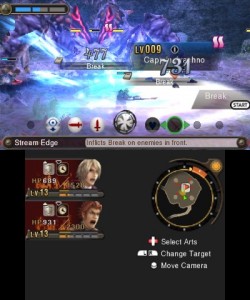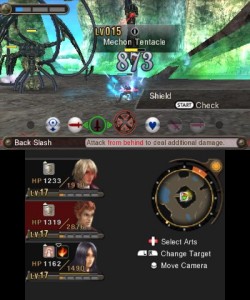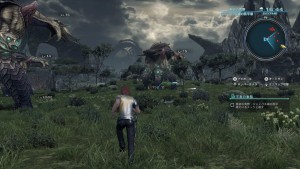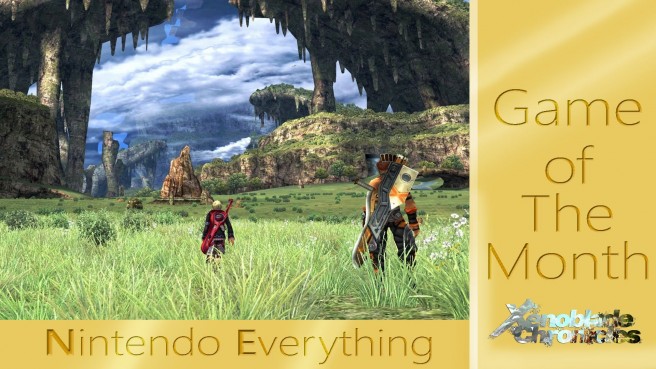The Awakening of the Giant – A comparison of Xenoblade Chronicles’ and X’s soundtracks
Posted on June 14, 2015 by Jarop(@gamrah) in 3DS, Features, Game of the Month, Wii, Wii U
Xenoblade Chronicles X has been out in Japan for quite some time and while the rest of us gaze enviously at the latest Xeno entry before it comes our way, it’s interesting to note some of the changes that have been made possible thanks to the Wii U. The boost in graphical power allowed Monolith Soft to flex their artistic muscle and craft a gorgeous open world, the improved online infrastructure allowed not only for interactions with other players but also the means to push out additional content (which is a staggering thought for a game with a story up around the 70 hour mark) and the most striking change came thanks to the dense, orchestral based soundtrack, which harvested a very different tone to Xenoblade Chronicles back in 2010. Moving away from the smaller ensembles covering any combination of rock, pop and classical tracks, Xenoblade Chronicles X was scored by Hiroyuki Sawano, renowned for more grand compositions focusing on a full orchestra sound, a stark contrast to the ensembles players had been exposed to previously. It was a different sound that was needed to accommodate the new direction of the game, but it was a fairly big risk to take as Xenoblade Chronicles’ soundtrack was so endeared by fans.

Xenoblade Chronicles director Tetsuya Takahashi stated that one of the goals with the Wii title was to break the traditional RPG mold in as many ways as possible. By bringing on a rather large team of composers he was able to successfully achieve this, as each one of them brought expertise in a different genre or style. VGM titan Yoko Shimomura was brought on to contribute the main theme, opening track as well as a number of others, bringing her ability to craft iconic melodies with her creative use of string-based ensembles. With a resume featuring themes from the likes of Street Fighter II, Super Mario RPG and the Kingdom Hearts series it’s no wonder Takahashi sought after her talents, as each of those soundtracks are a testament to the power of the themes she produces. No matter what the setting, Shimomura is renowned for writing themes that stick, which is pivotal to making memorable moments part of every playthrough.
Relative newcomers ACE+ (Chico Yamanaka + Tomori Kudo of ACE, who when partnered with Kenji Hiramatsu form ACE+) both composed and performed their contributions to the soundtrack, and were responsible for arguably the game’s most iconic track in Gaur Plains. The ACE+ compositions primarily consist of a traditional rock line-up combined with a number of different additions from strings to a fuller percussive sound and having a team of composer/performers really brought an elevated level of energy to every track they produced.
Finally, industry veteran Yasunori Mitsuda rounded out both the team and the soundtrack with the game’s ending theme Beyond the Sky. Mitsuda is no stranger to an RPG setting and the soothing vocals and sensitive accompaniment from the strings and piano evoke feelings both triumphant and solemn, which was the perfect way to finish the journey. His talents are also well established, thanks to his extensive work on the beloved Chrono Trigger and Chrono Cross soundtracks which feature some of the most iconic melodies the genre has ever known.

The team have commented in an Iwata Asks column that the biggest challenge they faced when composing the soundtrack was keeping a unified sound, as you would expect when dealing with 6 different composers across a variety of different ensembles. Thankfully, Iwata himself admitted that throughout his playthrough of Xenoblade Chronicles he was unable to identify who was responsible for what tracks, which shows the level of communication between the composers throughout the development process. Whether it was a brassy battle theme, a soothing vocal ballad or an atmospheric string melody it all managed to stay focused, giving the soundtrack an incredible amount of versatility and consistency.
Before we’d even heard an excerpt from Xenoblade Chronicles X’s soundtrack, the stark change in composer lineup from a team of composers down to a single person was already a telling sign of a drastic change. Despite being successful with a team of composers with Chronicles in 2010, Takahashi and directing partner Koh Kojima opted to bring on Hiroyuki Sawano to handle the entire soundtrack for the Wii U RPG. Sawano’s resume is substantially different to that of the composers of Xenoblade Chronicles with a background is primarily in anime, most notably Attack on Titan and Kill la Kill. His writing style favours more grand, large-scale works, generally in some sort of orchestral setting. This allows for the creation of a rich texture, perfect for painting the mood of the game’s diverse environments thanks to the large number of colours and voices he had to work within the confines of an orchestra. With a background in television and more traditional media, Sawano’s sound is more akin to that of a film score where the purpose of the music is often to evoke a mood for a setting, rather than to draw a connection with a specific character or place. That’s not to say it’s the only trick he has in his bag, as a number of tracks combine elements of electronic and rock or even depart from the orchestral setting entirely. Both soundtracks posses a great deal of versatility, but the change in compositional intent is evident through the move to a single composer and the focus on more dense, fleshed out works.

Soundtracks are never created in isolation and as the focus shifted from a character centric story to a larger, grander adventure with X, it’s only natural that the music go with it. Xenoblade Chronicles intimately follows the journey of Shulk, Fiora, Dunban and a cast of other characters through a very deliberate narrative experience, where every player will have an identical progression through the story. The player’s time is filled watching these relationships grow and the purpose of the soundtrack is to help draw association to places these moments take place and the people that are involved. Take Shulk’s reunion with Fiora, the sombre string melody floating over the thin chamber accompaniment sets the perfect tone for this delicate moment and adds a great deal of weight to one of the game’s most gentle moments. There are many different open-world elements in the game, but the progression of these characters and their relationships are clearly set at the forefront of the experience.
From what we know so far, this doesn’t appear to be the case with Xenoblade Chronicles X thanks to the ability to customisable your protagonist and constantly interact with any number of other human players online. No doubt due to the increased processing power they had to work with on the Wii U, Monolith Soft sought out a scope for the game that was much larger. It was now possible to show off glorious landscapes to explore, fly mechs and battle on and it’s possible that the soundtrack was crafted to enhance those feelings when traversing through a world that is both massive and beautiful. The world is awe inspiring and the music should be right there with it, which is why the progression to a full orchestra to capture that ‘epic’ feeling wherever possible makes sense. Of course, there are still playable characters that accompany the protagonist on their quest and the plot will inevitably be a crucial part of the experience, but with a game as stunning as Xenoblade Chronicles X, it’s a completely natural progression to want to draw more attention to the beauty of the world wherever possible. After all, it was something they’d set out to do on the Wii but couldn’t due to hardware limitations.

Xenoblade Chronicles X’s soundtrack caught a lot of fans off-guard because of how different it was to its predecessor, but the shift was essential as the new title required the music to serve a different purpose. The soundtrack of Xenoblade Chronicles had a team of composers, allowing for a great deal of versatility in ensembles and styles, and was effective due to the narrative focus the game had. The strong melodies and varying textures helped strengthen the player’s relationship with the game’s cast and helped make every play through memorable. While plot is still a pivotal part of Xenoblade Chronicles X, the constant interactions with players online and customisation options made the shift to more grand score seem natural, as the soundtrack serves to emphasis the scope of the adventure and the beautiful world it takes place in. Both soundtracks are incredibly effective in what they set out to achieve, but the change in composers was necessary as the series continues to evolve, making the music of the Xeno series more powerful and memorable with each iteration.
